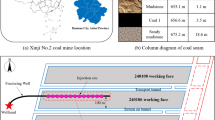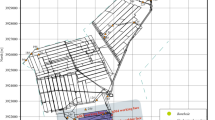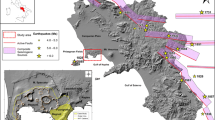Abstract
In a reliability assessment of hydraulic fracturing, the efficacy of hydraulic fracturing must be evaluated, and the source properties and magnitude of micro-earthquakes induced by hydraulic fracturing in a coal mine need to be quantified. Firstly, the changing trends of the number and energy of micro-seismic events induced by hydraulic fracturing with high-pressure water were examined, and the hydraulic fracturing effect was evaluated by micro-seismic location. Then, the source parameters (seismic moment M0, source radius R, corner frequency f0, radiated seismic energy E, stress drop △σ, and apparent stress σa) were calculated using the Brune model and the grid-search method, and the relationships between M0 and other source parameters were analyzed. Finally, the source parameters between micro-earthquakes induced by hydraulic fracturing and those induced by mining were compared, and the relationship between Mw (moment magnitude) and ML (local magnitude) of a micro-earthquake induced by hydraulic fracturing was ascertained. The results show that most micro-earthquakes occur in the initial stage of water pressure increase during hydraulic fracturing. In addition, the occurrence of several micro-earthquakes does not correspond strictly to the significant decrease of water pressure; the locations of micro-earthquakes can be used to evaluate the effect of hydraulic fracturing. The source parameters of micro-earthquakes induced by hydraulic fracturing in the Xieqiao coal mine can be obtained from the Brune model and the grid-search method. Corner frequency f0 decreases with increase in seismic moment M0, source parameters of R and E, as well as △σ increase with increase in seismic moment M0, but the apparent stress σa fluctuates around a certain value; the relationships between the other source parameters and M0 of micro-earthquake induced by hydraulic fracturing are consistent with that of a micro-earthquake induced by coal mining. Considering Mw, ML1 can be better used to calculate the magnitude of micro-earthquakes induced by hydraulic fracturing. Through Mw and ML1, the magnitude of a micro-earthquake induced by hydraulic fracturing can be evaluated. Our results improve the evaluation of the hydraulic fracturing effect, the understanding of source properties, and evaluation of the magnitude of micro-earthquakes induced by hydraulic fracturing. It is found that these micro-earthquakes are within the safe controllable range, and the hydraulic fracturing process of the Xieqiao coal mine is reliable and safe.












Similar content being viewed by others
References
Abercrombie, R. E. (1995). Earthquake source scaling relationships from − 1 to 5 ML using seismograms recorded at 2.5 km depth. Journal of Geophysical Research, 100, 24015–24036.
Aki, K., & Richards, P. G. (2002). Quantitative seismology, Second Edition, ISBN 0-935702-96-2 (p. 704). Sausalito: University Science Books.
Albright, J. N., & Pearson, C. F. (1980). Location of hydraulic fractures using microseismic techniques. SPE 9509.
Albright, J. N., & Pearson, C. F. (1982). Acoustic emission as a tool for hydraulic fracture location: Experience at the Fenten Hill hot dry rock site. Society of Petroleum Engineers Journal, 22(4), 523–530.
Aleksander, J. M., Richard, A. L., & Dmitriy, A. M. (2010). Routine micro-seismic monitoring in mines. In Australian earthquake engineering society conference. Perth, Western Australia, 1–33.
Allmann, B. P., & Shearer, P. M. (2009). Global variations of stress drop for moderate to large earthquakes. Journal of Geophysical Research Solid Earth, 114(B1).
Boatwright, J. (1980). A spectral theory for circular seismic sources, simple estimates of source dimension, dynamic stress drop and radiated seismic energy. Bulletin of the Seismological Society of America, 70, 1–27.
Brune, J. N. (1970). Tectonic stress and the spectra of seismic shear waves from earthquakes. Journal of Geophysical Research, 75, 4997–5009.
Chen, D., Wang, E. Y., & Li, N. (2019). Analysis of microseismic source parameters and focal mechanism in Qianqiu coal mine. Journal of China Coal Society, 44(07), 2011–2019.
Dou, L. M., & He, X. Q. (2008). Technique of classification forecasting rock burst in coal mines. Journal of China University of Mining & Technology, 36(6), 717–722.
Durrheim, R. J. (2010). Mitigating the risk of rockbursts in the deep hard rock mines of South African, 100 years of research. In J. Brune (Ed.), Extracting the science, a century of mining research, (pp. 156–171). Denver, Colorado, USA: Society for Mining, Metallurgy, and Exploration, Inc, .
Ge, M. (2003). Analysis of source location algorithms, Part I. Overview and non-iterative methods. Journal of Acoustic Emission, 21, 14–28.
Ge, M. (2005). Efficient mine microseismic monitoring. International Journal of Coal Geology, 64, 44–56.
Glazer, S. N. (2016). Mine Seismology. Springer, Cham: Data Analysis and Interpretation.
Hasegawa, H. S., Wetmiller, R. J., & Gendzwill, D. J. (1989). Induced seismicity in mines in Canada—An overview. Pure & Applied Geophysics, 129(3–4), 423–453.
Huang, B. X., Liu, C., Fu, J., & Guan, H. (2011). Hydraulic fracturing after water pressure control blasting for increased fracturing. International Journal of Rock Mechanics and Mining Sciences, 48, 976–983.
Huang, B. X., Wang, Y. Z., & Cao, S. G. (2015). Cavability control by hydraulic fracturing for top coal caving in hard thick coal seams. International Journal of Rock Mechanics and Mining Sciences, 74, 45–57.
Ide, S., Beroza, G. C., Prejean, S. G., & Ellsworth, W. L. (2003). Apparent break in earthquake scaling due to path and site effects on deep borehole recordings. Journal of Geophysical Research Solid Earth 108(B5).
Imanishi, K., Ellsworth, W. L., & Prejean, S. G. (2004). Earthquake source parameters determined by the SAFOD Pilot Hole seismic array. Geophysical Research Letters, 31(12), 399–420.
Ito, T. (2008). Effect of pore pressure gradient on fracture initiation in fluid saturated porous media, Rock. Engineering Fracture Mechanics, 75(7), 1753–1762.
Jeffrey, R., Mills, K., & Zhang, X. (2013). Experience and results from using hydraulic fracturing in coal mining. In Proceedings of the 3rd international workshop on mine hazards prevention and control. Australia: Brisbane.
Lenoach, B. (1995). The crack tip solution for hydraulic fracturing in a permeable solid. Journal of the Mechanics & Physics of Solids, 43(7), 1025–1043.
Li, X. L., Cao, Z. Y., & Xu, Y. L. (2020). Characteristics and trends of coal mine safety development. Energy Sources, Part A, Recovery, Utilization, and Environmental Effects, 2020, 1852339. https://doi.org/10.1080/15567036.
Li, N., Fang, L. L., & Sun, W. C. (2020). Evaluation of borehole hydraulic fracturing in coal seam using the microseismic monitoring method. Rock Mechanics and Rock Engineering 1–19.
Liu, S. M., Li, X. L., & Wang, D. K. (2020). Experimental study on temperature response of different ranks of coal to liquid nitrogen soaking. Natural Resources Research. https://doi.org/10.1007/s11053-020-09768-3.
Lurka, A. (2008). Location of high seismic activity zones and seismic hazard assessment in Zabrze Bielszowice coal mine using passive tomography. Journal of China University of Mining and Technology, 18(2), 177–181.
Madariaga, R. (1976). Dynamics of an expanding circular fault. Bulletin of the Seismological Society of America, 66(3), 639–666.
Mayeda, K., & Walter, W. R. (1996). Moment, energy, stress drop, and source spectra of western United States earthquakes from regional coda envelopes. Journal of Geophysical Research Solid Earth, 101(B5), 11195–11208.
Papanastasiou, P. C. (1997). A coupled elastoplastic hydraulic fracturing model. International Journal of Rock Mechanics & Mining Sciences, 34(3–4), 240.
Prejean, S. G., & Ellsworth, W. L. (2001). Observations of earthquake source parameters at 2 km depth in the long valley Caldera, Eastern California. Bulletin of the Seismological Society of America, 91(2), 165–177.
Schuster, C. L. (1978). Detection within the wellbore of seismic signals created by hydraulic fracturing. SPE 7448.
Smith, M. B., Holman, G. B., & Fast, C. R. (1978). The Azimuth of deep penetrating fractures in the Wattenberg Field. Journal of Petroleum Technology, 30(2), 185–193.
Tang, C. A., Tham, L. G., & Lee, P. K. K. (2002). Coupling analysis of flow, stress and damage (FSD) in rock failure. International Journal of Rock Mechanics and Mining Sciences, 39(4), 477–489.
Waldhauser, F., & Ellsworth, W. L. (2000). A double-difference earthquake location algorithm, method and application to the Northern Hayward Fault, California. Bulletin of the Seismological Society of America, 90(6), 1353–1368.
Wu, R. T. (2006). Some Fundamental Mechanisms of Hydraulic Fracturing. Doctor thesis of philosophy in Georgia Institute of Technology.
Xu, N. W., Li, T. B., & Dai, F. (2015). Microseismic monitoring and stability evaluation for the large scale underground caverns at the Houziyan hydropower station in Southwest China. Engineering Geology, 188, 48–67.
Zhang, G. Q., & Chen, M. (2010). Dynamic fracture propagation in hydraulic re-fracturing. Journal of Petroleum Science and Engineering, 70, 266–272.
Zhang, R., Liu, J., & Sa, Z. Y. (2020). Experimental investigation on multi-fractal characteristics of acoustic emission of coal samples subjected to true triaxial loading-unloading. Fractals, 28(5), 2050092.
Zhou, J. R., Yang, T. H., & Zhang, P. H. (2017). Formation process and mechanism of seepage channels around grout curtain from microseismic monitoring, a case study of Zhangmatun iron mine, China. Engineering Geology S0013795216304902.
Acknowledgments
The research presented in this article is supported by the Fundamental Research Funds for the Central Universities “Inversion of source parameters and mechanism of coal and rock rupture under true triaxial conditions” (JU200178).
Author information
Authors and Affiliations
Corresponding author
Rights and permissions
About this article
Cite this article
Chen, D., Li, N. & Wang, Ey. Reliability Assessment of the Hydraulic Fracturing Process in Coal Mine Based on the Analysis of Micro-Seismic Source Parameters. Nat Resour Res 30, 2317–2332 (2021). https://doi.org/10.1007/s11053-021-09840-6
Received:
Accepted:
Published:
Issue Date:
DOI: https://doi.org/10.1007/s11053-021-09840-6




